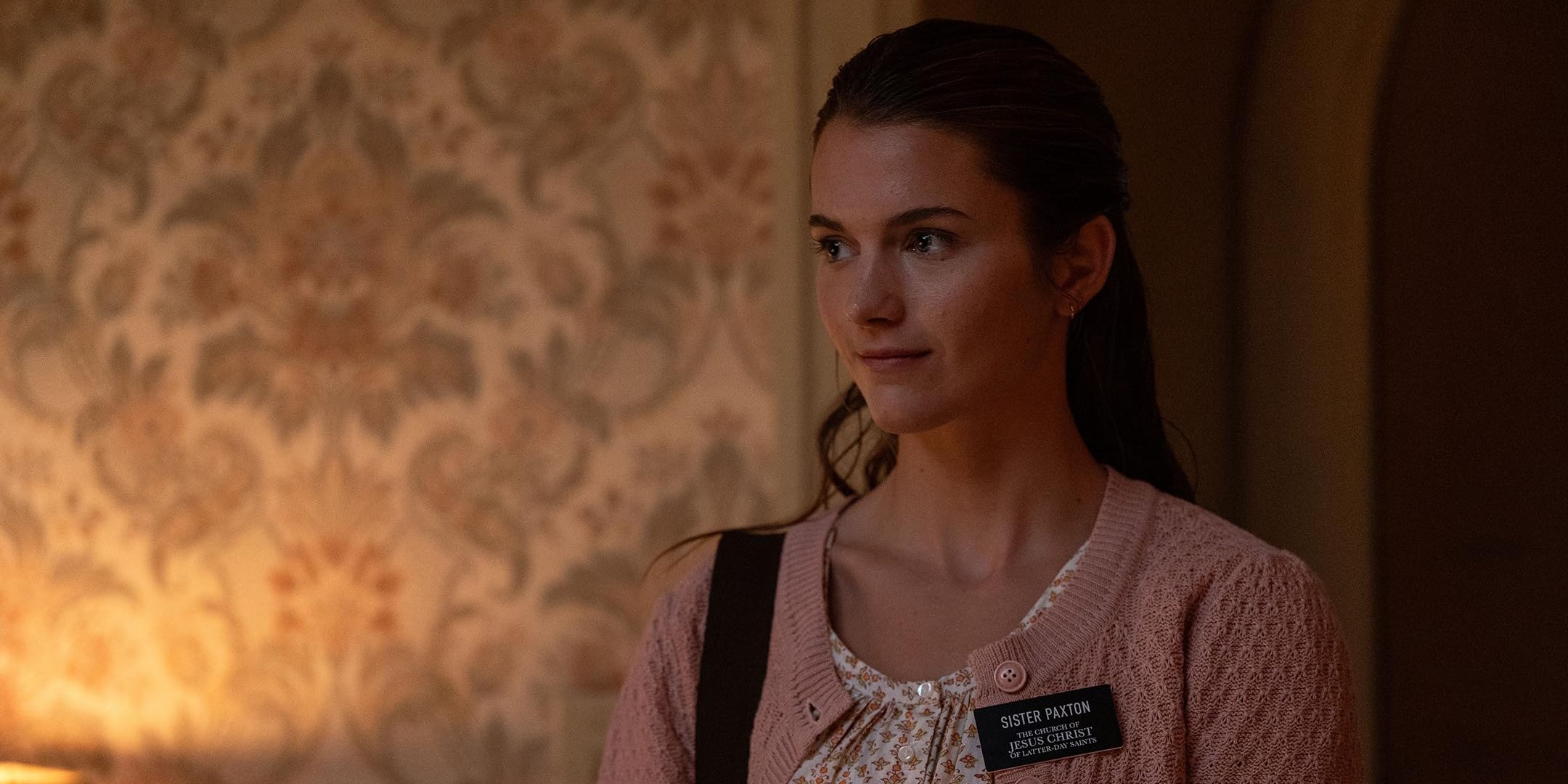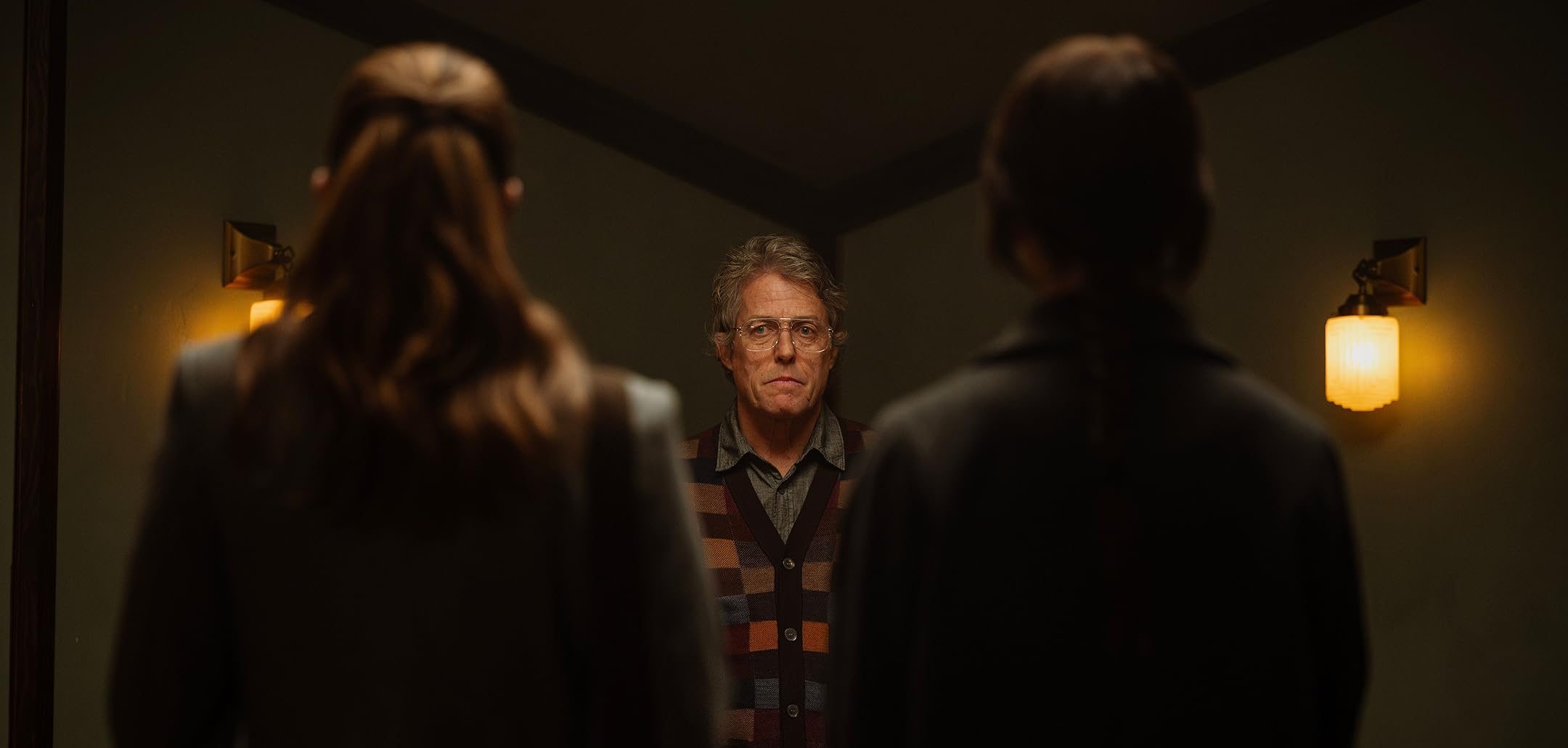Scott Beck and Bryan Woods’ horror film ‘Heretic’ ends with several ambiguous developments concerning the fates of Mr. Reed and the two Mormon missionaries, Barnes and Paxton. The reclusive religious scholar leads the latter to the cellar of his house, where she learns a startling revelation concerning the extent of the former’s cruelty. While he immerses himself in the revelry of trapping the young woman for good, she tries her best to survive from his clutches. Paxton unexpectedly receives assistance from a person close to her, which threatens the life of the homicidal scholar who traps her. Even though the movie concludes heartwarmingly, there are several ambiguities that are guaranteed to raise questions among viewers! SPOILERS AHEAD.
Heretic Plot Synopsis
‘Heretic’ begins with an introduction to Sister Barnes and Paxton’s missionary work. Even though their peers and strangers ridicule them, they remain committed to converting people to the Mormon faith preached by The Church of Jesus Christ of Latter-day Saints. This missionary work leads them to the house of Mr. Reed, who has expressed interest in converting to Mormonism. While a storm rages, the two young women start to talk about their faith to the reclusive man, who welcomes them inside. When they clarify that they cannot be in the company of an unknown man alone, he tells them that his wife will join them.

While Barnes and Paxton settle in the house, Reed tells them that his wife is making a blueberry pie and will meet them shortly. Soon, the two missionaries become stunned to know that the person in front of them has extensive knowledge about not only Mormonism but also other religions. However, the discussion soon turns unsettling for the young women, who wish to leave the place as soon as possible. Their eagerness only increases when they realize that the smell of the blueberry pie is actually coming from a scented candle rather than an actual pie.
Barnes and Paxton lie to Reed that they must return to their convent after receiving a call, only for him to call them out since cell signals are unavailable inside his house. The two missionaries realize they are trapped inside the property, making them plead to the man to get out. He asks them to choose one among the two doors present in a peculiar part of his house to escape through the back end of the premises. Unfortunately, both doors lead to the house’s basement, where they come across a strange woman. Reed tells them that the woman, who is referred to as the Prophet, will eat a poisoned pie, die, and resurrect.

As Reed states, the Prophet eats the pie and dies. The man makes Barnes and Paxton check the deceased woman’s pulse and confirm that she is dead for good. Meanwhile, the elder at the two missionaries’ convent drops by the house to find them. The religious scholar lies to the elder that he never met the women, eliminating the major chance they had to escape from Reed. As Barnes and Paxton immerse themselves in hopelessness, the Prophet resurrects. The man rejoices at this turn of events and asks the two women to kill themselves to resurrect like the Prophet. He even claims that their resurrection will mark the beginning of a new religion.
Barnes and Paxton decide against following Reed’s instructions, only for the latter to slash the throat of the former. After seeing her companion becoming a motionless body, the young missionary claims that the Prophet never resurrected. She adds that the woman who returned from death is a similar woman who swapped herself with the dead body. To prove her right, Paxton goes to the house’s cellar and discovers a body lying there. She continues to walk through the cellar, only to end up in a makeshift prison where many more women are imprisoned. That is when she realizes she is in the exact place where Reed wants her to be.
Heretic Ending: Why Does Mr. Reed Make Barnes and Paxton Play a Game?
As far as Mr. Reed is concerned, every religion is a system used by respective communities to manipulate and control its followers to do things they wouldn’t necessarily do on their own. Whether it be Christianity, Islam, or Judaism, they all use similar frameworks to play with the lives of the believers in his eyes. This conviction is what dominates his understanding of the system of religions. When people like Sister Barnes and Paxton challenge him with their lives, which are surrendered to their respective faiths, Reed becomes eager to prove them wrong. In other words, his every action is aimed at establishing all religions are controlling and manipulating.

Reed can put forward his point verbally. He can deliver monologue after monologue about how religions decide every action of their followers/believers, starting with whom or what to believe and ending with what sort of undergarment one should wear. In Barnes and Paxton’s case, their faith determines how to live their lives comprehensively. Their beliefs influence not only their desires but also their inclination to spend time with a man. When Reed looks at them, all he sees are two young women who are outrightly controlled and manipulated by Mormonism. To show them the extent of this influence, he decides to do what their religion does to them: control and manipulate.
Reed wants to establish that “control” is the single true religion. To prove it, he mimics religious figures and mocks religious events. He uses the concept of resurrection, which is one of the fundamentals of Christianity, to lure Barnes and Paxton to his plot. He uses two doors that represent the binary of heaven and hell to mock the afterlife. Finally, he allows Paxton to revel in the glory of making a discovery — the body swap — like how religions celebrate tricks and deception in the name of God. The young missionary follows the breadcrumbs and pursues truth like a winner without realizing that she is walking to her own prison, where she is expected to live in the dirt.
When Paxton ends up in the cellar, Reed exposes his control over her. She realizes that through a series of carefully pre-planned or pre-orchestrated developments, the homicidal scholar has controlled her to arrive in her own prison. Through this realization, Reed claims that he is the same as the religions in the world because both use tricks to deceive the targets into doing what they want, irrespective of the perception of a monster or devil associated with him. Reed designed the game as an allegorical representation of the influence of religions on believers. The only difference is, in his eyes, he does not have a holy scripture in his name.
Do Sister Barnes and Mr. Reed Die For Good?
Even though Mr. Reed boasts mastery in elaborate planning, he overlooks two details that threaten his life. First of all, he does not confirm the death of Sister Barnes after he slashes her. Secondly, he does not anticipate Sister Paxton to stab him with a letter opener. As far as the first case is concerned, he does not have any problem watching Barnes die a slow death, which explains why he does not bother to confirm her death. As a homicidal, sadistic person, he must have drawn enjoyment from the pain the elder missionary suffers from. However, this move costs him his life after Paxton stabs him with a hidden weapon.

In Reed’s mind, the elaborate game will end when Paxton accepts her defeat and becomes the new inmate in the prison in the cellar. He does not expect her to escape from his clutches, especially after stabbing him. To make matters worse for him, Barnes clutches the last drop of life in her to hit him with a wooden plank with nails that pierce through his body. Although there is a lot of talk about resurrection, the elder missionary hasn’t died in the first place to return from death. She has been merely unconscious after losing a considerable amount of blood. Still, her triumph over the supposed death and the antagonist is unignorably biblical and resembles the resurrection of Jesus Christ to mark his victory over sin and death.
Barnes spends the last drain of life in her to save Paxton from Reed. After hitting the latter, she dies beyond a shadow of a doubt. A similar return to life is not anticipated in the case of the homicidal scholar. Unlike the two young missionaries, he is significantly old enough to survive two deadly attacks that result in immense blood loss. Even if there is a last drop of life in him, it won’t be enough for him to crawl out of the basement and leave the highly intricate house. Therefore, he appears to be dead for good, like his killer, Barnes.
How Does Sister Paxton Escape? What is the Significance of the Butterfly?
After Mr. Reed’s death, Sister Paxton finds a way to escape from the house, where she nearly dies, like Barnes. She finds a prototype of the property and delves into the same rather than trying to find her way out of the maze. Her intelligence helps her locate an opening through which she escapes to the outer world. Along with her, a butterfly escapes, which flies away after stopping by her palm for a while. The butterfly represents freedom from Reed, which is enjoyed equally by the young missionary and the insect. In one of the earlier scenes of the film, the same butterfly is shown caged inside the homicidal scholar’s house.

The butterfly remains within the walls since the house has covered windows and doors that barely stay open. Its fate changes when Paxton finds a window that can be opened. They cherish their freedom from a vicious being together by giving company to each other while escaping from captivity. The butterfly’s example also sheds light on the irony of Reed trapping it, intentionally or unintentionally, with the missionaries. The homicidal scholar hates religions because they manipulate believers, control the followers’ actions, and limit the freedom of the affiliated members. These exact reasons are celebrated by Reed, which makes him the exact thing he hates wholeheartedly.
Through Paxton and the butterfly’s captivity, the horror thriller clarifies that Reed has been captivated by the features of religions like any other practitioner. His locked-up abode represents the limitation of freedom often associated with numerous faiths. Paxton and Butterfly’s escape marks their survival from this irony as well.
Does Sister Paxton’s Faith Change?
Mr. Reed makes Sister Paxton play a life-threatening game to expose the nuances of the countless existing religions to her. He repeatedly discredits the same to prove that being a believer means nothing. His appropriation of religious elements to teach her a lesson further raises the question of whether there is any difference between the antagonist and the religions in the world. However, there is no evidence to state that these efforts have changed her mind. On the contrary, she chooses to pray to God when she faces death, which clarifies the strength of her faith.

Irrespective of Reed’s best efforts to discredit religion, Paxton benefits from it. She is able to handle a lot of confusion and indecisiveness with religion as a support system. Her faith also provides her with a God who can be relied upon to be present with her whenever she is troubled. Even though the entity does not appear physically, she senses his presence when confronting death at a short distance, which makes her less alone. At least, by clinging to her faith, she does not have to ever die alone like Reed.
Paxton knows that praying will not change the results of any events or developments. Still, she finds comfort, hope, and even distraction in the same, which have their own values. That’s also the same with her faith. It may not be able to solve her problems, but it can give her a sense of support in troubling times, which counts in her eyes.
What Will Happen to the Women in Mr. Reed’s Cellar
‘Heretic’ concludes without revealing what will happen to the surviving Prophets in Mr. Reed’s cellar. Since Paxton survives from the homicidal scholar, she is expected to inform the authorities of their existence in the house. The women may receive immediate medical attention soon after the missionary reaches out to officials for assistance. The young woman has always displayed compassion, even when she faces death. When she meets the Prophets together for the first time, she cares for them despite facing death herself. This caring mentality may rescue the Prophets from dying in the cellar without receiving any help.
Read More: Is Heretic (2024) Based on a True Story?


You must be logged in to post a comment.